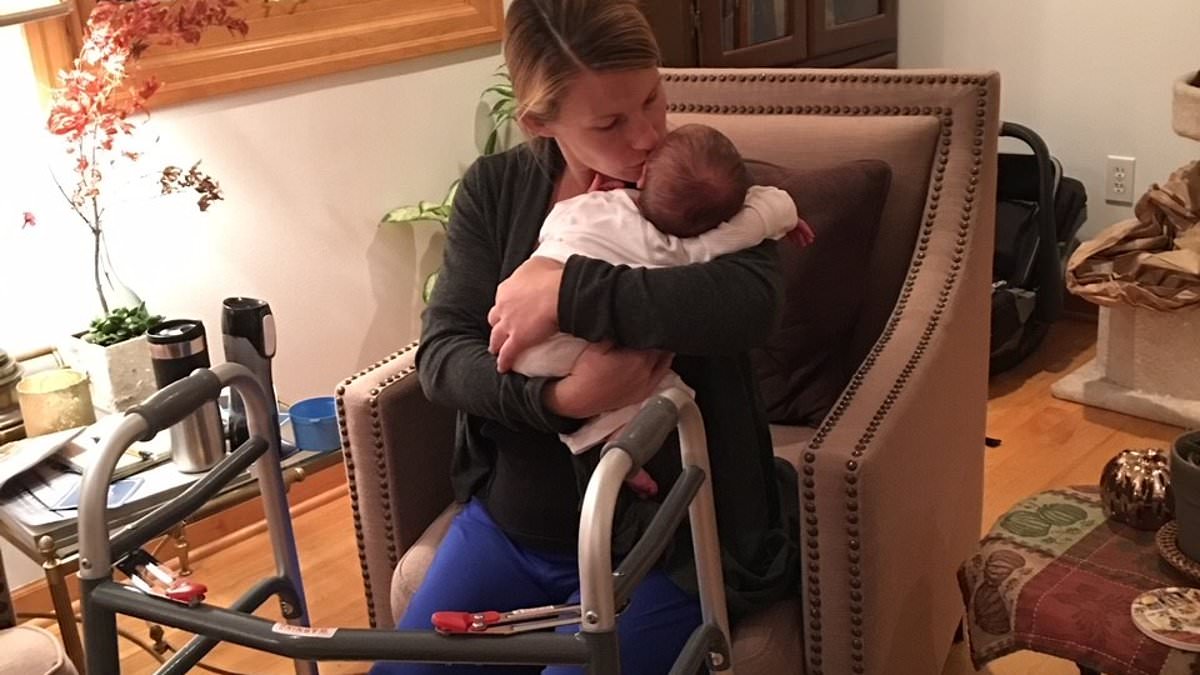For most new mothers, the first 48-hours of their newborn baby’s life is purely magical.
They think of little else than their new love bubble, and perhaps how much they’re looking forward to a decent night’s sleep.
But for Elizabeth Waggett, then 36, it was also the time she was told she was facing a lifetime of paralysis, following a catastrophic childbirth injury that she was unaware had even happened.
In August 2021, she gave birth to her daughter Darcey, following a grueling 72-hour labor. When it was time to get up and go to the bathroom, she realized she couldn’t move.
Everything from the pelvis down felt ‘dead.’ Elizabeth, an artist who lives in Texas, had received an epidural injection more than 24 hours earlier. But doctors said its numbing effect should have worn off by now.

Elizabeth Waggett, now 40, found herself unable to move from the pelvis down after giving birth to her daughter, Darcey, in 2021

The mother-of-one (pictured here 2 months after giving birth) relied on a wheelchair for seven months, before switching to a walker when some of her nerve damage spontaneously repaired
A neurologist visited her bedside and believed she’d likely suffered nerve damage as a result of a prolonged stretch in her pelvis, and if the feeling hadn’t returned yet, there was a chance it never would.
‘My world collapsed,’ she told DailyMail.com. ‘I was thinking, just like, why me? Why has this happened to me? I felt like a failure because I had this new baby and I couldn’t get up to go to her. It wasn’t supposed to be like that.’
Two weeks later, tests showed her sciatic nerve — the largest nerve in the body that runs down the spine to the back of the legs — had sustained severe damage that was unlikely to repair.
It marked the beginning of a two and a half year nightmare which saw the new mother confined to a wheelchair for seven months, unable to get up and tend to herself, let alone her baby.
Ms Waggett said: ‘My husband had to give up his job to take care of me full time — take me to the toilet, help me shower and feed myself, as well as looking after our baby.
‘Most days I couldn’t move from the bed.
‘And all the time I was thinking of how much of a failure I was. I thought my daughter would be better off without me. I remember wishing someone would put me out of my misery.’
Miraculously, and against all odds, she did, seven months later, regain the feeling in her lower limbs, but it came with a cost.
‘If someone was to say “do you know what it’s like to have your leg chopped off”, I’d say, yes — because that’s what nerve pain feels like.’
For the better part of a year she slept little more than 30 minutes most nights, jolted awake by the agony.
Today, she relies on daily painkillers and weekly physical therapy and has been diagnosed with post traumatic stress disorder (PTSD) as a result of her post-birth experience.
Ms Waggett told DailyMail.com: ‘It still feels like I have two limbs attached to my body, rather than my legs. I can’t run or jump and walking long distances triggers pretty bad pain the next day, but I push myself.’

Elizabeth Waggett says she was never planning for children, but was elated to find out she was pregnant at the end of 2020
DailyMail.com has learned that tens of thousands of US women are suffering a similar fate to Elizabeth’s every year.
Studies estimate around 40,000 new moms experience some form of nerve injury due to childbirth each year.
A Facebook community of survivors has two and a half thousand members, and offers a supportive forum for victims who have suffered injuries ranging from temporary pain to permanent paralysis.
It is a little-known complication that has also been acknowledged by experts leading the arena of research into childbirth injury.
‘We know a lot of cases of paralysis go undiagnosed because obstetricians don’t typically see women for follow up appointments,’ says Professor Giulia Muraca, perinatal epidemiologist and gynecology researcher at McMaster University.
‘For most people the problem resolves after a couple of months, but in some cases it can continue for two to three years.’
Professor Muraca describes the complication as ‘rare’, but estimates prevalence to be higher than previous studies — around two percent of births, which is 72,000 cases per year.
Alarmingly, she says it is likely terrifying complications like this are on the rise, as maternity units find themselves increasingly stretched with overwhelming case loads and few specialist midwives on call.

Another woman affected by paralysis after childbirth is 38 year-old Reagan Smutny from Seattle, who said nurses pulled her legs back towards her ears during a four-hour marathon pushing session
Neurologists’ scans two and then six months after Ms Waggett’s injuries revealed she’d suffered a positioning stretch injury in her sciatic nerve.
In other words, the position she was put into during labor had caused extreme damage to nerve fibers, disrupting the signals sent between her legs and her brain.
The hospital staff made a critical mistake that caused this, she said.
A nurse maneuvered her into a ‘frog’s legs’ position, and told her to remain this way — as some research shows this stance encourages the baby’s head to drop.
‘I stayed like that for at least seven hours,’ says Elizabeth. ‘Something didn’t feel right but my legs were heavy and numb because of the epidural, and every time I tried to move my legs back towards the center of the bed, they’d flop back out.’
She says when she did succeed in re-positioning her limbs, the nurse came back into the room to ‘correct’ them.
The potential for an epidural shot to cause paralysis is relatively well-known.
The injection, which contains anesthetic to temporarily numb pain in the lower body, and is delivered to the space in-between your spinal nerves, is thought to carry a one in 54,000 risk of permanent paralysis.
This can happen for a number of different reasons, including if the needle is badly positioned and hits a nerve or blood vessel, a serious infection in the site of the injection and low blood pressure.
However, a recent major study involving 125,000 women found there may be benefits of epidurals that span beyond pain relief.
The anesthetic was found to reduce the risk of heart attacks, sepsis and the medical need for hysterectomy in the weeks following birth.
Now, experts say nerve damage related to lower body positioning should be granted more attention.

Elizabeth is now working on art projects that focus on ‘lightness after dark’, which she says is a metaphor for her traumatic experience
‘In certain positions, the baby’s head can press on the branches of the sciatic nerve that line the pelvic muscle, causing damage,’ says Professor John De Lancey, pelvic reconstruction surgeon at University of Michigan Health.
Professor Muraca says both the sciatic nerve and the femoral nerve — which runs from the pelvis through the leg — are at risk while holding certain positions, particularly when the legs are bent and splayed out to the side.
‘Hip flexion, for instance having your legs stretched apart for a very long period of time, could cause serious damage,’ she says.
An independent neurologist later told lawyers that Ms Waggett’s symptoms were indeed the result of an injury to the sciatic nerve, likely due to ‘overstretching’ the muscles and tissue.
Other women have told DailyMail.com of similarly life-wrecking symptoms they suffered as a result of birth-related pelvic nerve injuries.
One is 38 year-old Reagan Smutny, who had no feeling from her hips to her toes for nearly three months after giving birth to her daughter, now nine, in 2015.
It was a further six months before she could make it up and down the stairs on her own.
The event planner, from Seattle, still suffers with numbness in her right leg and cannot flex her knee, nearly a decade later.
‘It was heartbreaking — all I wanted to do was take care of my baby but I couldn’t even take my own underwear off,’ she says.
‘I couldn’t use the bathroom alone, take a shower or even move to a different room. I was incapable of being a mother.’
When her husband went back to work six weeks later, he would carry her down the stairs in the morning and place her on the sofa besides an assisted walking device called a Zimmer Frame.
‘I’d wrap my legs around the metal legs and shuffle to and from the kitchen to get whatever the baby or I needed. Then my husband would come back from work and carry me back upstairs.’
Neurologists determined that, in both legs, she’d suffered damage to the femoral nerve, which runs through the groin and upper thigh and controls movement in the hips, knees and front of the leg.
The injuries occurred during the second stage of labor, when a woman is 10cm dilated and ready to push.

The Waggett family recently received an admission of fault from the hospital, as well as a $30,000 payout
‘I was pushing in the lithotomy position [frog’s legs], for four hours. The nurses were like “yeah let’s do this”, pulling my legs back towards my ears as I leaned forward with all my strength.’
Because Raegan had received an epidural a few hours earlier, she was immune to any pain from the position that may have motivated her to move.
Eventually, her OB advised the baby’s head was too large to be delivered vaginally, and she was rushed to the operating room for an emergency C-section, where her baby was successfully delivered.
Two days later, her medical team visited her hospital bed to encourage her to start moving in preparation for going home.
‘I remember saying; “I don’t think I’ll be able to move my legs”, but they told me to try, thinking I’d be fine once I was out of bed.
‘I got up and immediately fell to the floor. My legs gave way beneath me.
‘I’m grateful that the neurologists were there and recognized the problem. I was told the feeling would come back within six weeks. But when it didn’t, I was told, maybe it won’t at all.’
Reagan now dedicates her time to writing children’s books, as well as helping other women who suffer severe nerve injury after childbirth, via her website nervedamagefromchildbirth.com.
‘I get hundreds and hundreds of emails from women every month, spanning 80 countries.
‘Most of them recover to about 75 percent of their pre-birth mobility. But there are some who rely on devices like walkers and wheelchairs for several years.’
These stories come amid a burgeoning crisis in maternity care across the US.
A report published late last year revealed the stark differences in access to timely and adequate services across regions.
A staggering one in three counties in the US are ‘maternal care deserts’, where there are no hospitals or birth centers offering obstetric care or providers, according to a 2022 report by campaign group March of Dimes.
It means some 2million women of childbearing age would be forced to travel long distances for basic care.
This is thought to be fueled by the increasing numbers of hospitals shutting down maternity services due to staff and funding shortages; 217 hospital obstetric units closed between 2011 and early 2023, according to health care consulting firm Chartis.
And while maternal mortality rates dipped slightly in 2022, they have doubled since 1999, according to a recent study published in JAMA.
Campaigners have long argued many of the problems could be remedied if midwives — specialists in pre and post natal care — had a greater presence in hospitals across the country.
In the UK, there are some 43 midwives per 1,000 births compared to America’s four per 1,000, according to one report.

The 40 year-old artist says she feels the ability to breastfeed her baby, Darcey, helped her to feel ‘useful’ at a time when she felt ‘like a failure’.
‘The problem is obstetricians are mostly familiar with C-section deliveries and complications, but they don’t see other problems that occur afterwards, such as those affecting vaginal or pelvic health, and therefore don’t think about prevention,’ says Professor Muraca.
She adds there is a culture of ‘not listening’ to women on maternity wards.
‘I get emails every week from women who feel isolated, alone and without anyone to talk to about their problem,’ she says.
Professor De Lancey is keen to highlight the type of childbirth injury that is far more common than paralysis — and that he hears of often.
Some 25 percent of women who have given birth vaginally suffer a pelvic floor disorder, including incontinence, as a result of damage to their pelvic muscles and ligaments during labor.
Around three to five percent of women suffer a third or fourth degree vaginal tear, which stretches from the vagina to the muscle that controls the anus, leading to incontinence in both the front and back.
Thankfully, Elizabeth experienced none of these complications, describing the 20-minute birth part as ‘beautiful’.
‘It was over in two hefty pushes’,’ she says.
Some seven months after she became paralyzed, Elizabeth felt a surprise twinge in her left toe.
‘After that, the feeling in everything else started to come back pretty quickly’, she said. ‘First it was a twitch in my toe, then my foot, then my calf. I thought, oh my god I’ll be healed in no time!’
While half a year of virtually no movement had destroyed any strength in her lower body, daily exercises, strength training and dogged determination gradually got her back on her feet.
She said: ‘My right foot has been the slowest to improve. It still looks a bit like a claw — there’s no muscle in it whatsoever, it’s just skin and bone, so putting it flat on the ground is still painful.’
Exercise is crucial for helping repair nerve injury as it increases the flow of oxygen and blood to the affected area, which can stimulate the growth of new nerve cells.
Today, Elizabeth is determined to use her experience for good. She is working on a body of work that falls under the theme, ‘the lightness that comes after dark’, inspired by her lengthy healing process.
She is also working with the Texas hospital to introduce new guidelines that instructs nurses and other medical professionals to move laboring women’s bodies every 30 minutes.
A month ago, nearly three years on from the devastating injury, the family received a $30,000 financial settlement from the hospital, which admitted fault. The majority of the cash went towards their legal fees bill.
Elizabeth said the experience has swayed her from having any further children.
‘It wasn’t ever really part of the plan anyway, but now I would be petrified,’ she says.
Regean, however, did have another child — getting pregnant just shy of three years after her injury.
‘I was so desperate for my daughter to have a sibling because I am very close to mine,’ she says. ‘But I was terrified. I was waiting for something to go wrong the entire pregnancy, and I wasn’t at all excited.’
It wasn’t until Regean first held her newborn daughter, after a surprisingly uncomplicated labor, that she could revel in the idea of a new addition to her family.
‘I realized what I was waiting for. I needed to know that I could hold her — and walk.
‘Once I was standing up with her in my arms, I could relax.’










